As past readers know, for the past several years I’ve been documenting some of our travel experiences through blog posts. (The most recent of these was Pat and Dave’s Tremendous Tropical Trek, describing our travels in March of 2023, from Fort Lauderdale to the Panama Canal and back with Viking Ocean Cruises.) We are among those most fortunate of people who are able to travel about the world in our Golden Years, and we like to schedule these trips well in advance, so we always have something to look forward to.
As we basked in the winter glory of our “southern home” – our Minneapolis condo – back in January, even as we eagerly anticipated the upcoming Panama trip, we were trying to decide where to go in the fall. One of our most enjoyable past adventures was a jaunt with the RV we formerly owned to Acadia National Park in Maine (that one was dubbed Pat and Dave’s Eastern Escapade) back in August and September of 2021. During that trip, we had considered continuing on to Nova Scotia, which we could barely see across the Bay of Fundy as we enjoyed the scenery at Acadia. We didn’t make it that time, but vowed to go sometime in the future. So, as we were tossing around ideas for fall travel, we decided to do just that. For reasons which I can’t quite recall, much less comprehend, it was agreed that I would plan out the trip and make the necessary arrangements.
Fast forward to mid-May, when the following conversation took place.
Pat: “How are you doing on planning that Nova Scotia trip?”
Dave: “Ah …, well …”
Pat: “You’d better get going on that before you head to the cabin for the summer, or else nothing will get planned at all.”
Dave: “Sure thing, dear. I’ll get right on it.”
It just so happened that I chose that moment to go down to the lobby and collect our mail. And it just so happened that in the mail was a brochure from Road Scholar, the travel group formerly known as Elderhostel. And it also just so happened that Road Scholar was offering a tour entitled “Best of the Canadian Maritimes,” a 12-day motor coach tour encompassing Nova Scotia, Prince Edward Island, and New Brunswick. I quickly scanned the brochure on my way back up in the elevator, then entered our condo and resumed the conversation:
Dave: “You can relax now. I’ve got it all planned.”
We had gone on Road Scholar programs three times previously, to Key West, Hilton Head, and St. George, UT, though only the latter has been chronicled in the blog (Pat and Dave’s Eclectic Electric Road Trip). As a result, we were familiar with Road Scholar and were confident that the program would be excellent. So that was that, and we happily marked the trip on our calendars for September 16 through 27. Our plan was to drive from the cabin in Grand Marais, MN, to Thunder Bay, Ontario, then fly to Halifax, Nova Scotia, to join the tour group on Saturday, September 16. The “Best of the Maritimes” program began with a tour of Halifax on Sunday, September 17.
Sunday, September 17, 2023: On Sunday morning, we took the hotel shuttle to the airport and took a train some 25 miles into the city for a nice tour. Here’s a photo from that excursion:

Those world travelers among you are probably thinking: “That photo doesn’t look like Halifax at all.” Right you are! In fact, Pat and I were in Toronto while the Road Scholar group was touring Halifax, and I have no idea what they actually saw there. Why were we in Toronto? Our best laid plans were upended by Mother Nature, as Hurricane Lee forced cancellation of all flights into Halifax on Saturday. The first leg of our flight, from Thunder Bay to Toronto, was unaffected, but our flight to Halifax was rescheduled for Monday, September 18, so we hunkered down in a hotel near the airport to wait. We spent much of the day on Saturday on the phone with Road Scholar representatives trying to sort out what to do. On the advice of Road Scholar, we booked tickets on the Maritime Bus departing from Halifax International Airport at 3:50 PM Monday and arriving at a place called Nyanza, near the hotel in Baddeck where the tour group would be staying, at 8:30 PM. The Road Scholar advisor assured us we could catch a taxi from Nyanza to the hotel.
Meanwhile, we continued to look for an earlier flight that might get us to Halifax on Sunday. After repeated attempts to contact Air Canada – at the airport customer service desk, on line, and by phone – I finally spoke with an Air Canada agent Sunday morning. After giving me a condescending lecture about the hurricane, she reluctantly agreed to check all earlier flights, confirming that there was nothing available that would get us to Halifax prior to 2:30 PM Atlantic time Monday, by which time the Road Scholar tour would have left for parts east. Heaving sighs of resignation, we decided to take the UP Express train from the Toronto Pearson International Airport to Union Station in downtown Toronto and have our own self-guided city tour.
So, while the Road Scholar group was touring Halifax, we schlepped around the bustling, international city of Toronto. From the UP Express terminal at Union Station (UP stands for Union-Pearson, by the way) we walked through the SkyWalk to the CN Tower and then to the Harbourfront Center, taking in the sights of modern, glass and steel high-rise buildings, water taxis, tour boats, and sailboats flitting about the harbor, and the city airport located on an island in Lake Ontario.

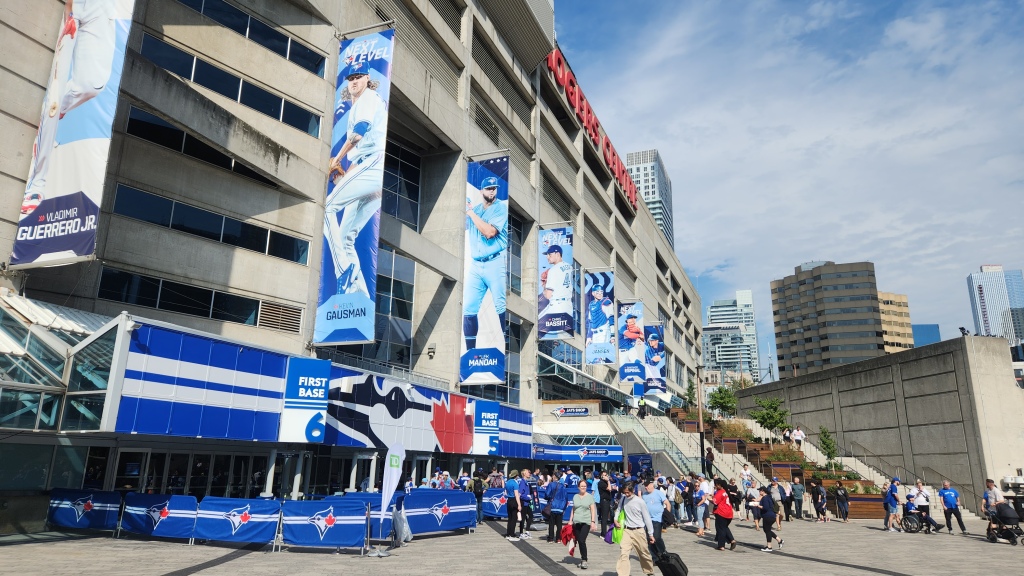
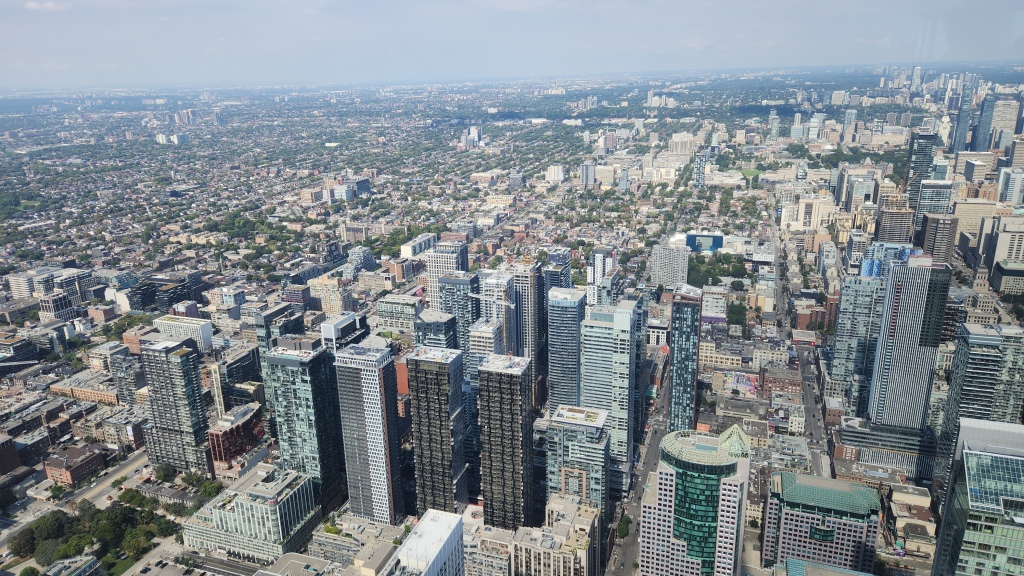
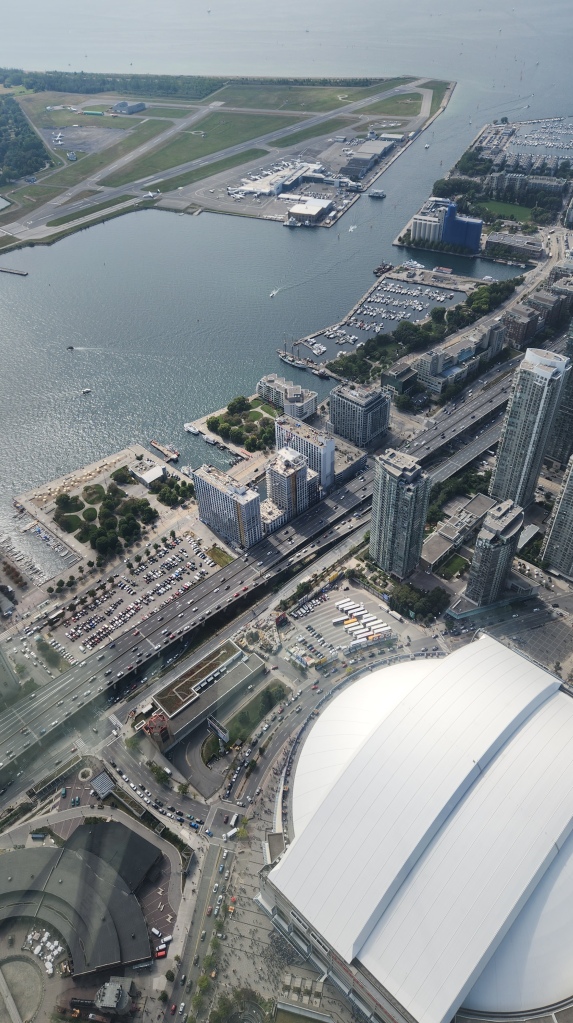

I was mightily impressed by the CN Tower, which rises 1,815 feet, towering above the Rogers Center, the roofed stadium where the Blue Jays play. CN Tower is the tallest free-standing structure on land in the Western Hemisphere and the tenth tallest free-standing structure in the world. Interestingly, we learned that it gets hit by lightning about 75 times each year. We went up to the main observation level at 1135 feet and then up to the SkyPod at 1,467 feet, taking in the spectacular views before returning to terra firma. My only regret is that we didn’t stay ten minutes longer – the roof of the Rogers Center was closed as we entered the elevator to go down, but then opened as we descended a few minutes before the start of a baseball game, so I missed a great aerial view of the ballpark.
As we walked around the city, the one discordant note for me was that there are almost no “old” or historic buildings in the downtown area, and the handful that remain stick out like sore thumbs. The impression I got was of an ultramodern city that has no interest in its own history. Nevertheless, I was very glad to have the chance to experience it.

Monday, September 18, 2023: Monday turned into an all-day travel event. We left our hotel in Toronto at 9:00 AM EDT, arrived at Halifax International Airport at 2:30 PM ADT, and boarded the Maritime Bus at 3:50 PM. The somewhat crabby bus driver informed me: “There’s no such place as Nyanza; you’re going to Wagmatcook.” Somewhat taken aback, I tried to enjoy the scenery as we wound our way eastward, stopping to discharge and/or pick up passengers at some half-dozen stops and eventually disembarking at an Ultramar Gas Station in Wagmatcook at 8:35 PM. Per the original theory, that was where we would catch a taxi to Auberge Gisele’s Inn in nearby Baddeck, where the Road Scholar group had checked in earlier in the day. As we stood outside in the dark, an elderly gentleman emerged from the gas station (which was quickly locked by the lone attendant, presumably to prevent either Pat or I from trying to enter the premises). The gentleman regaled us with some local lore before climbing on a four-wheeler and driving off with a friendly wave, leaving us alone and somewhat unsettled.
There was one minor problem with the taxi plan, however. There are no taxis in Wagmatcook, Baddeck, Nyanza (which does in fact exist – it’s just not an actual stop for the Maritime Bus service), or anywhere else remotely close. Fortunately, we had tumbled to this earlier in the day and, through a series of phone calls and text messages, had arranged for the Auberge Gisele’s Inn manager to come and pick us up for a nominal fee. Which he did, and we were finally settled in to our cozy hotel room by 9:30 PM. The hotel staff had thoughtfully set aside the beef bourguignons dinners we would have eaten had we actually arrived with the Road Scholar group. They were quite delicious after microwaving, and we ate contentedly in our room, having finally caught up with our tour.
We later learned that the other tour participants had also taken a motorcoach from Halifax with a stop for a tour of the Alexander Graham Bell Museum, and were at that time attending a ceilidh (a Gaelic word pronounced “kay-lee”), a social gathering featuring Scottish songs, dancing, and storytelling. So, we missed those two things by being latecomers, replaced instead by our culturally-enriching, 12-hour travel day. I didn’t manage to get any pictures of interest, so instead I offer this map of the day’s journey from Halifax International Airport to Baddeck:
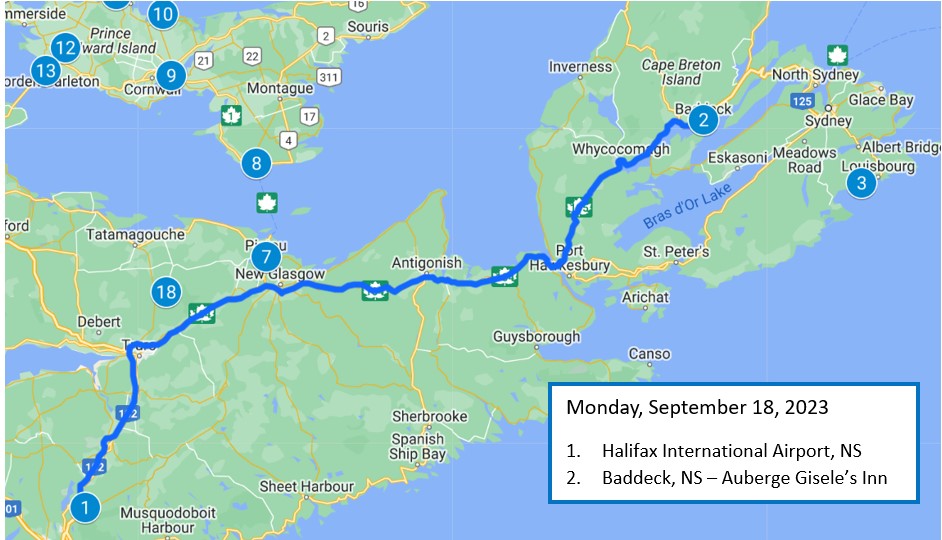
Tuesday, September 19, 2023: On Tuesday morning, we joined the other tour participants for breakfast at 7 AM, finding them to be a very congenial group. There were twelve other Road Scholars, hailing from California, Washington, Indiana, and Ohio, along with our knowledgeable and friendly tour guide from Prince Edward Island, Derrick Higgins. Four of the original eighteen tourists had canceled due to travel issues caused by the hurricane. (I presume those four had purchased trip insurance; we had not, so were more determined to catch up with the tour.) After breakfast we met our excellent bus driver, Kirby, also from PEI, as we made our way to the site of Fortress Louisbourg. This complement of fourteen tourists plus Derrick and Kirby remained together for the entirety of the trip.
Fortress Louisbourg is a National Historic Site restored by the Canadian Government to represent its condition in 1741. The original settlement was founded in 1713 by French settlers from Newfoundland. The major attraction of the site was the abundant supply of cod, which supposedly sometimes ran so thick that ships could not navigate the waters, and settlers could harvest the fish using buckets. Subsequently, the fishing port grew to become a major commercial port and a strongly defended fortress, with fortifications eventually surrounding the entire town. The walls were constructed mainly between 1720 and 1740. By the mid-1740s Louisbourg, named for Louis XIV of France, was one of the most extensive (and expensive) European fortifications constructed in North America.
The fortress was conquered by British forces in 1745, but then returned to the French in 1748 under the Treaty of Aix-la-Chapelle, which ended the War of the Austrian Succession. The British then established their own fortified town at Halifax. Louisbourg was recaptured by the British in 1758 as part of the general hostilities of the French and Indian War and the Seven Years War, and the British then used Louisbourg as the staging ground for their assault on Quebec. Having captured the fortress, the British expelled all French residents, known as Acadians, who would not pledge loyalty to the King of England. The Acadians dispersed to surrounding areas such as Prince Edward Island (known then as Ile-Sainte-Jean) and Newfoundland, and many travelled south to the Colonies or to Louisiana, establishing the Cajun presence there.
Our visit to the Louisbourg site included a walking tour with a guide, a lunch of soup, vegetables, and bread prepared in 1741 style, and free time to roam the grounds. Here are some photos – as you can see, it was rainy during our visit. We got caught in a downpour when we had reached the furthest point from shelter, eventually returning to the bus well soaked and moderately miserable.
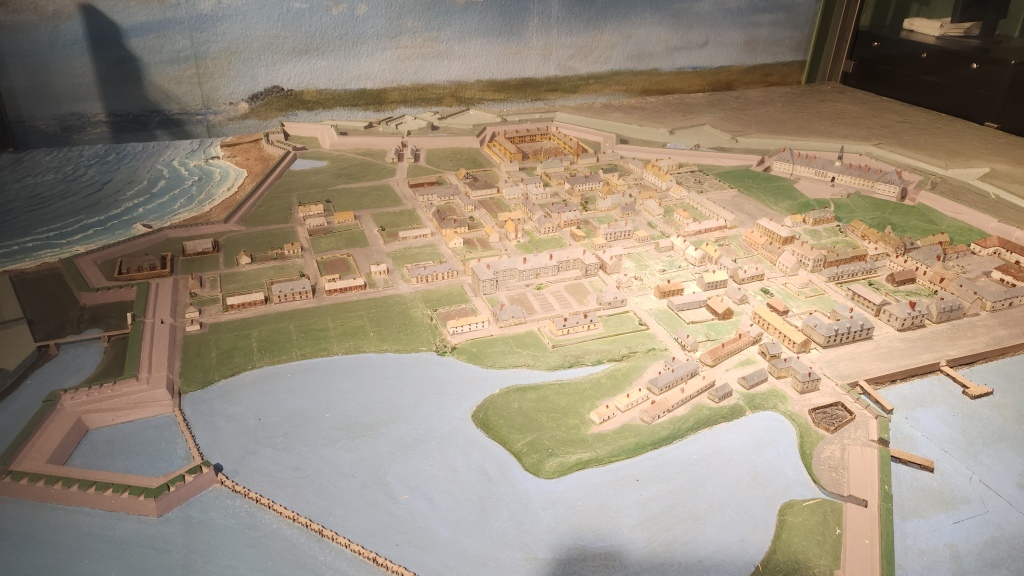
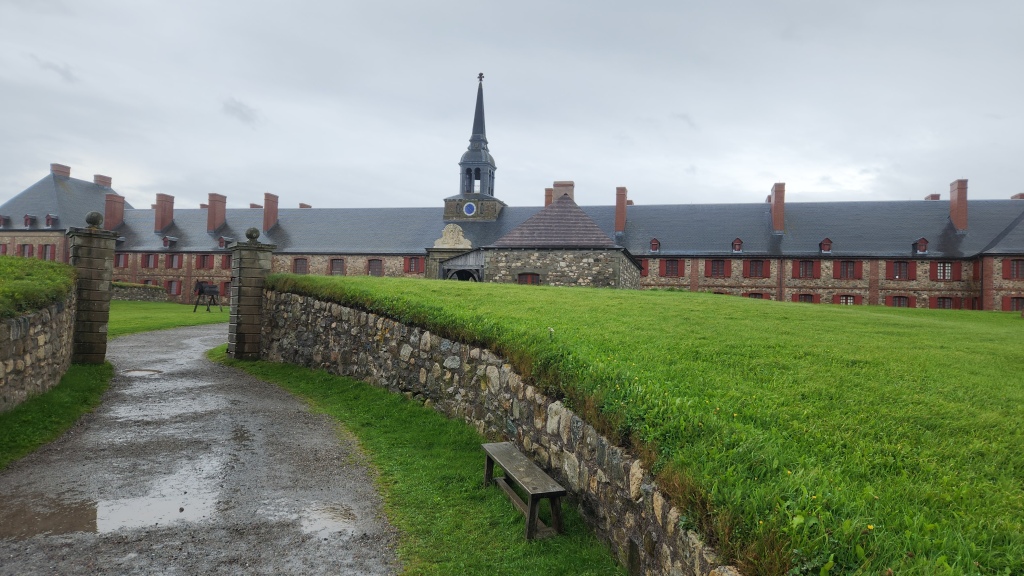
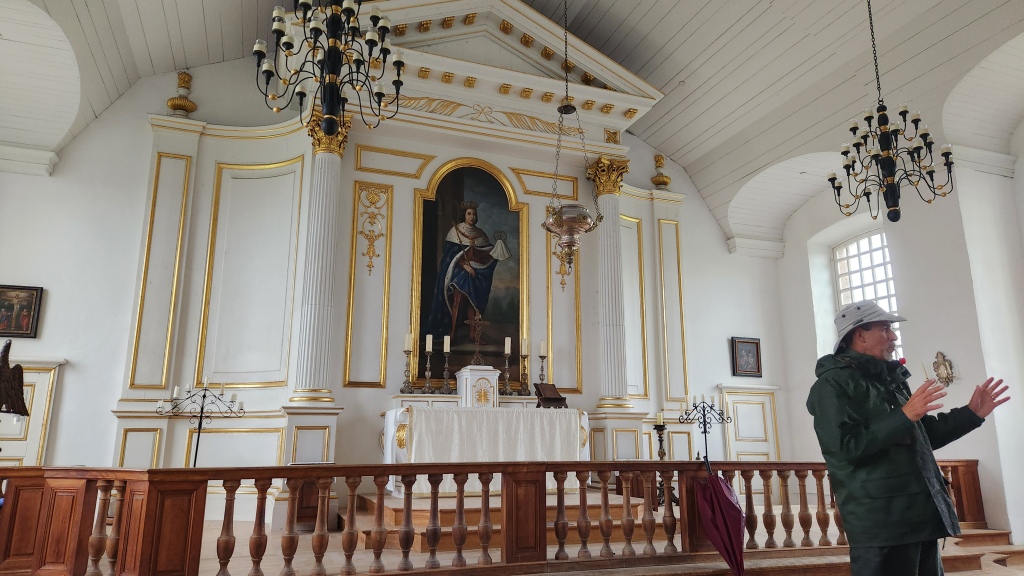



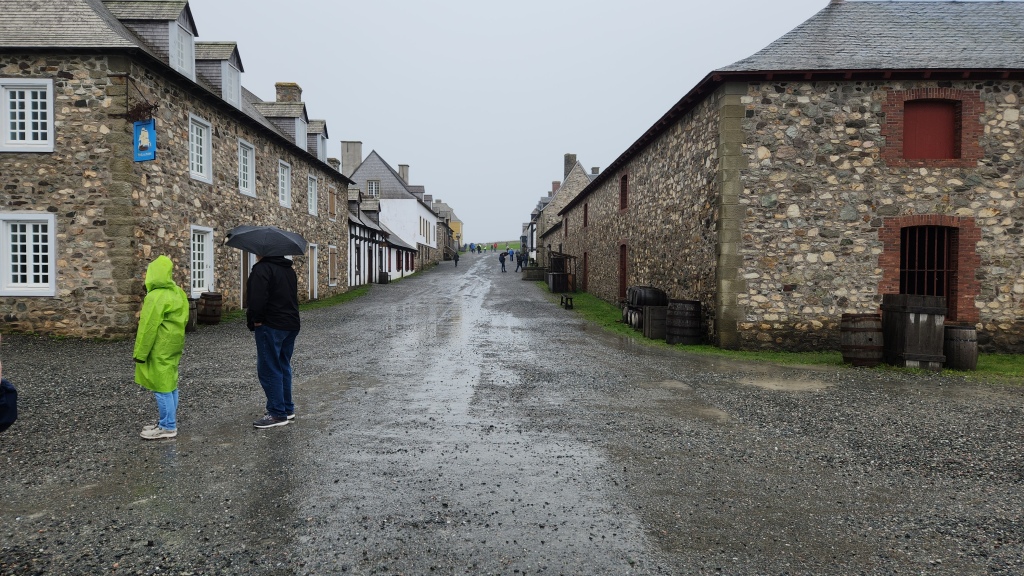
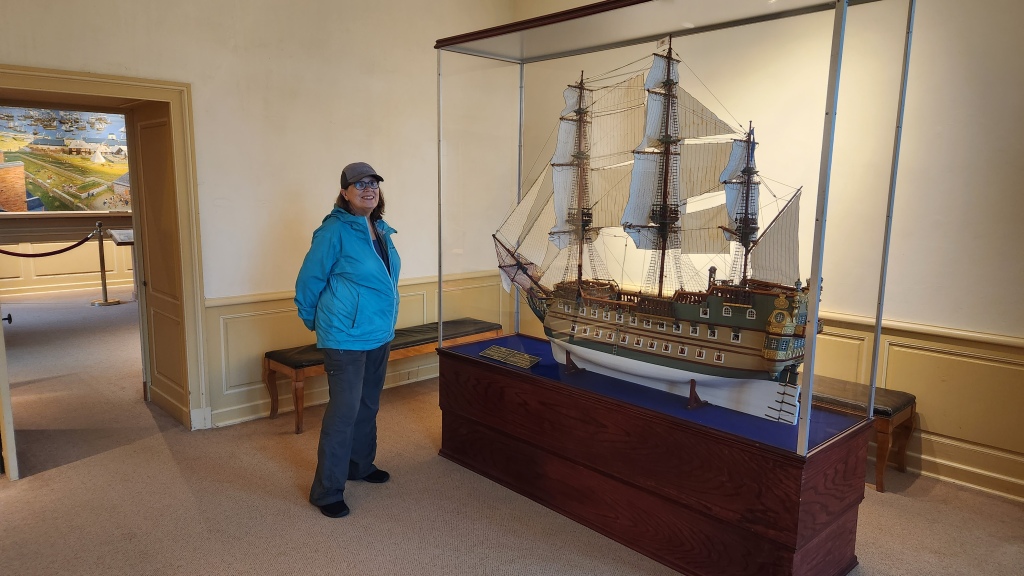

After the Louisbourg tour, we returned through the rain and mist to Auberge Gisele’s Inn for a change of clothes and dinner. Then we rode into town to attend a play at Theatre Baddeck entitled “The Hydrofoil Mystery,” centered on Alexander Graham Bell’s secret development of a hydrofoil to attack German U-Boats off the coast of Nova Scotia during World War I. It was well-done, especially for a local theater troupe.
As the bus was preparing to depart for Gisele’s Inn, a local woman engaged in a conversation with Kirby. I was sitting too far back in the bus to hear what was said, but eventually she retrieved her husband and boarded the bus, directing Kirby to drive along the narrow, hilly streets of Baddeck to a turnaround, then back to her home on Queen Street where Kirby dropped her off to encouraging shouts and laughter from our tour group. She was a long-time resident of Baddeck, an Acadian descendant, and she impressed us all with her wit and friendly demeanor. It was a fitting end to our first full day in Nova Scotia.
Here’s a map of the day’s travels:
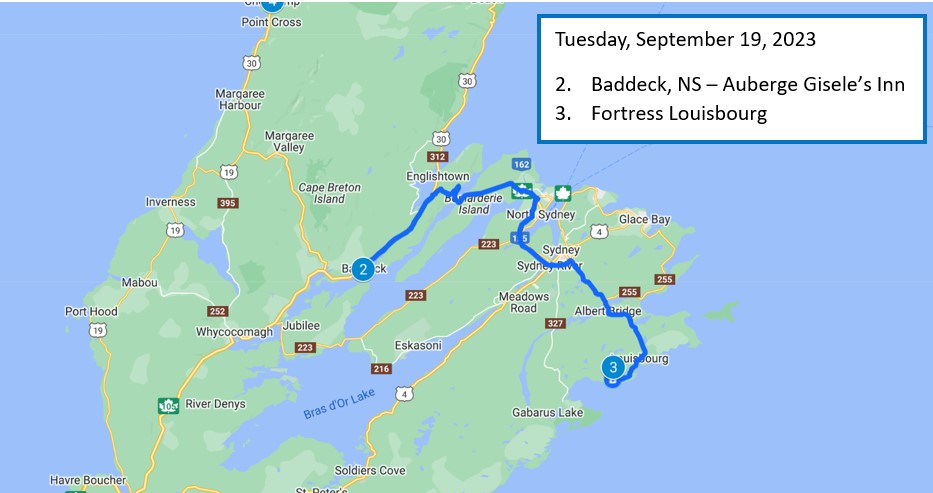
OK, that’s enough for the first installment.
In Part 2, I’ll cover Wednesday, September 20 through Saturday, September 23.
In Part 3, I’ll cover Sunday, September 24, through Wednesday, September 27.
Stay tuned …

So, how did the other passengers make the tour ontime? Did they get lucky and had flown in early? Or change their flights to be early once they saw the hurricane possibly coming?
LikeLike
Some were able to change to earlier flights, arriving Friday. Some were able to fly in on Sunday from airports with more scheduled flights. Some had actually mistakenly booked flights for Friday. With limited flights out of Thunder Bay, we really had no options other than to cross our fingers and hope the hurricane missed Halifax, which it obviously did not.
LikeLike